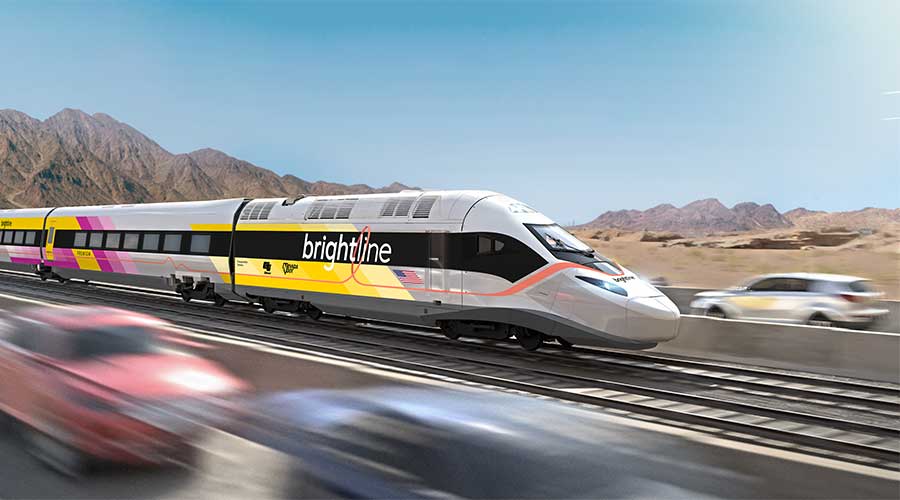Stay updated on news, articles and information for the rail industry
May 2009
Rail News: Passenger Rail
The Stimulus Express: Transit Agencies
By Angela Cotey, Associate Editor
Transit advocates long have touted the industry’s ability to create jobs; for every $1 billion invested in public transportation, 30,000 jobs are created, according to the American Public Transportation Association (APTA). Industry stakeholders also have long advocated the need for more (as in much more) federal funding, which could go a long way toward helping agencies bring their systems to a state of good repair, expand lines and add new services to meet growing demand. The stimulus package will give agencies an opportunity to prove both points.
“The biggest challenge we face in this industry is funding, so this really starts to deal with and address that challenge,” says DART’s Thomas. “I don’t think anyone believes it’s the end-all, cure-all, but it allows transit agencies throughout the country to start to put major capital projects in place.”
In early March, the FTA issued a federal register notice that included apportionments for transit agencies. The formula grants are based on pre-existing formulas that determine federal funding based on area population, as well as the number of route miles agencies operate over and number of passengers they serve.
“The feds didn’t want to create a new distribution mechanism, knowing that would delay getting money out the door,” says APTA Director of Government Relations Paul Dean.
The legislation also did not waive any of the “traditional” grant requirements, so grantees and federal agencies still must follow the lengthy environmental and labor review processes, says Dean.
“The hope and expectation is that this will fund a lot of projects that have already gone through those processes,” he says. “They didn’t want to put money toward brand-new or conceptualized projects because they wanted projects — and there are plenty of them out there — that are fairly far along in the process and would be under way, but for lack of federal dollars.”
Once the FTA issued the notice of funding availability, transit agencies immediately began filing applications for ARRA funds. Even though each agency has received an allotment of stimulus funds under the formula grants, projects still have to be approved by the FTA, which needs to ensure the projects are in fact “stimulating” the economy, creating an adequate number of jobs in the United States and meeting U.S. Department of Labor standards.
“There’s an enormous amount of electronic response required,” says Utah Transit Authority (UTA) Assistant General Manager and Capital Development Officer Mike Allegra. “It’s as transparent a bill I’ve ever seen.”
To date, agencies have filed applications for a range of projects — new lines or facilities, track or facility upgrades, rolling stock purchases or improvements, station rehabs — and their strategies for spending the funds differ based on which projects are ready to go and what goals they’re trying to accomplish.
Lump sum
For example, DART is in the midst of a program to double its existing 45-mile light-rail system and has chosen to spend almost all of its $61 million stimulus earmark on the Orange Line project.
“When people first started talking about this bill back in November, we listed all the projects we had in our 20-year financial plan that we thought might even be remotely close to qualifying,” says Thomas. “ The Orange Line was the most attractive since it had gone through the environmental process.”
In January, DART officials issued a notice to proceed on the project, awarding a design-build contract to a Kiewit/Stacy and Witbeck/Reyes/Parsons joint venture for the 9.3-mile line, which will run from Bachman Station on the Green Line to Belt Line Road and Valley View Lane on DFW Airport property.
“We moved the project forward hoping the stimulus program would be enacted into law, so you could kind of say we were betting on it,” says Thomas.
And while DART was planning to complete the Orange Line project regardless of whether it received stimulus funds, the federal dollars will free up DART monies for other projects. So far, the project has created 660 jobs.
Sharing the proceeds
At the Regional Transportation District of Denver (RTD), officials chose to split $72 million received in recovery act funds in the same way the agency currently splits its sales tax revenue: 60 percent for the base system and 40 percent for the FasTracks expansion program.
“For us, it was a very logical way to allocate the funds,” says RTD Assistant General Manager, Planning and Development Bill Van Meter. “With the current economy, we have real funding challenges on both the existing system and FasTracks, so the board made the decision to be consistent.”
On the base system side, RTD plans to replace some corroded rail clips on its Central Corridor, and upgrade safety and install intrusion detection systems on the Southwest Corridor — projects it wouldn’t have been able to complete in the coming years if not for the stimulus funds.
Under the FasTracks program, RTD will spend $2.6 million in stimulus dollars to expand light-rail platforms on the Central Platte Valley and Southwest corridors to accommodate four-car instead of three-car trains. The agency also will spend $9.8 million on early construction work for the $400 million Denver Union Station reconstruction project.
RTD officials also have identified several additional improvements the agency could make on the 12.1-mile West Corridor light-rail line that were not covered in a $308 million Full Funding Grant Agreement RTD obtained from the FTA earlier this year. So, RTD plans to spend another $9 million in ARRA funds to build bridges to accommodate drainage improvements, re-
allocate a street, and complete improvements to accommodate a second siding on the western side of the alignment.
As of press time, RTD had not yet issued contracts for any stimulus-related work.
“We are moving forward with processing paperwork, rewriting specs and scopes, moving forward with the procurement process, and adding language to contracts to make sure we’ll be able to get precise reports of direct job generation from contractors,” says Van Meter. “We have to move somewhat quickly, but we also don’t plan on risking any of these funds.”
UTA is using a good chunk of its $48 million in stimulus formula grants for a rail expansion program, as well. The agency is in the midst of its FrontLines 2015 program, which calls for building 70 miles of new rail lines in seven years. UTA plans to spend between $30 million and $35 million in ARRA funds to build a second light-rail maintenance facility to help support the rail expansion.
The project calls for converting an old 250,000-square-foot furniture warehouse into a light-rail vehicle repair shop. The facility would have been completed regardless, but the stimulus dollars will cover about two-thirds of the facility’s cost and help accelerate the project, which otherwise would have been years out, says UTA’s Allegra.
As of press time, UTA was waiting on final FTA approval for the project and hoped to soon advertise for bids. The agency expects to begin the project this summer.
UTA will use the remainder of its stimulus dollars to conduct preventive maintenance work on rail cars and buses, and purchase new buses. The stimulus-funded projects are expected to create between 500 and 550 jobs in all.
Meanwhile, the Greater Cleveland Regional Transit Authority (GCRTA) plans to use the majority of its $45 million in formula grant funding for rail system repairs and upgrades. In late April, the authority awarded its first major ARRA-related contract — $9.5 million to construct a new Puritas-West 150th station. Four Cleveland-area companies will complete the general contracting, electrical, plumbing, and heating and air conditioning work for the facility.
GCRTA also is currently evaluating bids for the design of a new Brookpark Station. The authority plans to use $1.2 million in ARRA dollars to fund the design work.
In addition, the agency plans to use stimulus dollars to rehabilitate the East 55th Street station, continue its rail-car rehab program, and upgrade track and signals.
“These are projects we certainly would not have been able to complete now — they were all maybe three, four, five years down the road because of a lack of capital funding,” says GCRTA CEO Joseph Calabrese.
The South Florida Regional Transit Authority (SFRTA) expects to spend its nearly $16 million stimulus allocation to purchase new rolling stock. The authority is seeking FTA approval to buy additional rail cars under a contract option with Rotem Co. The car builder is assembling the vehicles in Philadelphia.
SFRTA also is seeking ways it could “jump in on somebody else’s option” to purchase locomotives, says Executive Director Joe Giulietti.
The authority expects the rolling stock purchases to create about 480 jobs. SFRA wouldn’t have been able to purchase the cars or locomotives without the ARRA funds, says Giulietti.
Fast and furious
Other announcements of stimulus spending still were being released at a furious pace as of press time; a continuing stream of award announcements are expected through March 5, 2010 — the deadline for all transit formula grants to be obligated, said National Railroad Construction and Maintenance Association (NRC) President Chuck Baker during an April 22 Progressive Railroading Webcast entitled “How much and when: The stimulus’ impact on freight rail, rail transit and the high-speed passenger-rail industries.”
However, the FTA had yet to release guidelines for New Starts funding, the one portion of transit-specific stimulus funds that agencies will have to compete for. Industry and agency officials were anticipating which types of transit projects could qualify.
“Folks with projects under way and in place who just need federal dollars will get priority — if you don’t have a project already in the works in the New Starts category, it’s not likely you’ll get funding,” says APTA’s Dean. “The funding will most likely be for projects that already have a Full Funding Grant Agreement. In a lot of cases, the stimulus money will be used to expedite those projects.”
Projects under way at agencies in areas such as New York City, Utah, Phoenix and Seattle are likely candidates for the New Start funds, adds Baker. UTA’s commuter-rail extension from Salt Lake to Ogden and Mid-Jordan light-rail line — both of which have FFGAs already committed — could qualify for New Start stimulus funding, UTA’s Allegra believes. 
Transit — $8.4 billion
|
- Transit Agencies
- Amtrak
- Intercity Rassenger Rail & High-Speed Rail
Keywords
Browse articles on stimulus funding transit high-speed rail AmtrakContact Progressive Railroading editorial staff.


 2025 MOW Spending Report: Passenger-rail programs
2025 MOW Spending Report: Passenger-rail programs
 Gardner steps down as Amtrak CEO
Gardner steps down as Amtrak CEO
 Guest comment: Oliver Wyman’s David Hunt
Guest comment: Oliver Wyman’s David Hunt
 Women of Influence in Rail eBook
Women of Influence in Rail eBook
 railPrime
railPrime







